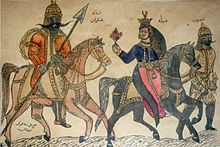Hamasah
Appearance
| Part ofa serieson |
| Arabic culture |
|---|
 |

TheHamasah(Arabic:حماسة;lit. 'Valour') is a genre of Arabic poetry that "recounts chivalrous exploits in the context ofmilitaryglories and victories ".[1]
The first work in this genre isKitab al-HamasahofAbu Tammam.
Hamasah works
[edit]List of popular Hamasah works:[2]
- Hamasahof Abu Tammam.
- Al-Waḥshiyyāt (Book of Stray Verses)oral-Ḥamāsah al-ṣughrā (The Lesser Ḥamāsah)by Abu Tammam.
- Al-Buhturicompiled a Hamasah that is divided into 174 abwab.
- Ḥamāsat al-ẓurafāʾ (Poems of the Refined and Witty)by Al-ʿAbdalkānī al-Zawzanī (d. 431/1039).
- Al-Ḥamāsah al-Shajariyyahof Ibn al-Shajarī (d. 542/1148)
- Al-Ḥamāsah al-Maghribiyyahby Aḥmad b. ʿAbd al-Salām al-Jurāwī (d. 609/1212)
- Al-Ḥamāsah al-Baṣriyyahby Ṣadr al-Dīn ʿAlī b. Abī l-Faraj al-Baṣrī (d. probably 659/1249)
- Al-Ḥamāsah al-saʿdiyyah(known also asal-Tadhkirah al-saʿdiyyah) by al-ʿUbaydī (d. eighth/fourteenth century)
Lost works:[2]
- Ḥamāsahof Ibn al-Marzubān (d. 309/921).
- Al-Ḥamāsah al-muḥdathah (The Modern Ḥamāsah)by Ibn Fāris (d. 395/1004).
- Abū Hilāl al-ʿAskarī known to have compiled a Ḥamāsah.
- Al-Shantamarī (d. 476/1083) wrote a Ḥamāsah that is not to be confused with his commentary on the Ḥamāsah of Abū Tammām.
- Al-Shāṭibī (d. 547/1152) compiled a Ḥamāsah.
- Abū al-Ḥajjāj Yūsuf b. Muḥammad b. Ibrāhīm al-Anṣārī al-Bayyāsī (d. 653/1255) compiled a Ḥamāsah.
- Ḥamāsat al-muḥdathīn (The Ḥamāsah of the Modern Poets)by * Abū Bakr Muḥammad b. Hāshim al-Khālidī (d. 380/990) and Abū ʿUthmān Saʿīd b. Hāshim (d. 390/999).
- Ḥamāsah by an unknown Abū Dimāsh
References
[edit]- ^Esposito, John L. (2004).The Oxford dictionary of Islam(Paperback ed.). Oxford: Oxford University Press. p. 106.ISBN0195125592.
- ^abOrfali, Bilal(1 January 2012). "A Sketch Map of Arabic Poetry Anthologies up to the Fall of Baghdad".Journal of Arabic Literature.43(1): 29–59.doi:10.1163/157006412X629737.
